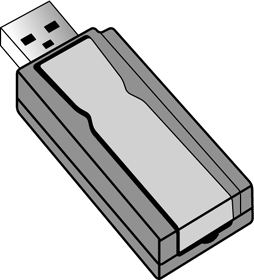Upgrade 5: Adding a Memory Card Reader
Upgrade #5: Adding a Memory Card ReaderIf you have a digital still camera, PDA, portable MP3 player, or other device that uses memory card storage, you need to somehow get data from that memory card into your PC. Although you can connect your camera or other device directly, it may be more convenient to use a memory card reader. All you have to do is insert your memory card into the reader, and then your computer will recognize the card as it would any removable storage device. Understanding Flash Memory StorageMemory cards don't have any moving parts; instead, they use flash memory (sometimes called flash RAM) to store data on tiny, nonvolatile memory chips. Unlike traditional computer RAM, which is wiped clean when the power is turned off, the contents of a flash memory device don't evaporate when the host unit powers down. Flash memory data is always there, ready to be addressed when the power is turned back on or when you insert the card into a new device, like a card reader. Because different devices have different storage needs, there are several different types of memory cards available all non-interchangeable. These include
Most memory card readers will accept all five of these media types, so you don't have to buy different readers if you have devices that use different types of cards. Installing a Memory Card ReaderThere are two types of memory card readers available. An external reader connects to your PC via a USB port, no fuss no muss. An internal reader installs inside your system unit, typically in one of the empty drive bays in the front of the case. As you might expect, I recommend you use the external type; they're much easier to install and configure. To install an external reader, just plug it into a free USB port. To install an internal reader, follow the instructions for adding a new removable disk drive earlier in this chapter. Windows should automatically recognize the media card reader as a new drive, and assign it a drive letter. You can now start transferring data to and from your memory cards, as if they were normal disk drives. An Alternate Type of Flash Memory: USB DrivesAnother popular form of flash storage, although not technically a card, is the USB drive. This type of removable "drive" is actually a flash memory device designed to function like removable disk storage. As you can see in Figure 4.7, these devices are small enough to be carried in your pocket or hung on your keychain. They plug directly into an open USB port on your computer, and are instantly recognized as a new disk drives by Windows. No special installation is necessary. Figure 4.7. Easy flash storage with a USB drive.
|
EAN: 2147483647
Pages: 206
